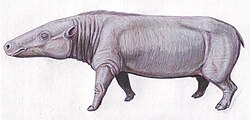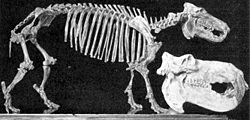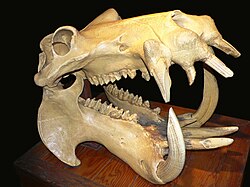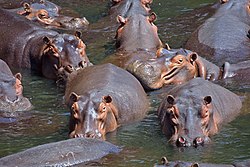Hippopotamus
The hippopotamus (Hippopotamus amphibius), or hippo, ancient Greek for "river horse" (Ιπποπόταμος), is a large mammal from Africa that usually eats plants. It is one of only two species in the family Hippopotamidae that are still alive. The other is the pygmy hippopotamus.
| Common hippopotamus | |
|---|---|

| |
| A hippopotamus in Tanzania | |
| Conservation status | |
| Scientific classification | |
| Unrecognized taxon (fix): | Hippopotaminae |
| Genus: | Hippopotamus |
| Species: | H. amphibius
|
| Binomial name | |
| Hippopotamus amphibius | |

| |
| Range map of the African hippopotamus. Historic range is in red while current range is in green.[2] | |
The hippopotamus is the second largest land animal in size and the third largest land animal in weight. The elephant is the heaviest and the white rhinoceros is the second heaviest, but a bit smaller than the hippo. The hippo is also the heaviest artiodactyl.
The hippopotamus is semi-aquatic. This means that even though it usually lives on the land, it spends a great amount of time in rivers and lakes where males lead groups of 5 to 30 females and young. In the daytime, they keep cool by staying in the water or mud. They give birth to baby hippos in the water, too. At dusk, they come out to graze on grass. Hippopotamuses rest together in the water, but they like to graze by themselves.
The hippopotamus has: a torso that is shaped like a barrel, a very big mouth and teeth, an almost hairless body, short legs and great size. It is the third largest land mammal, judging by its weight, which is between 1½ and 3 tonnes. The white rhinoceros weighs 1½ to 3½ tonnes and the three species of elephant weigh 3 to 9 tonnes. Even though it has short, fat legs, it can run more quickly than a human. Some hippos have run at 30 km/h (19 mph) for short distances. The hippopotamus is one of the fiercest animals in the world. It is often called one of the most dangerous animals in Africa. There are about 125,000 to 150,000 hippos in Sub-Saharan Africa. Zambia (about 40,000) and Tanzania (20,000–30,000) have the most hippos. They are threatened because they are losing their habitats and being poached for their meat and ivory teeth.
Etymology
The word "hippopotamus" comes from the ancient Greek ἱπποπόταμος, hippopotamos, from ἵππος, hippos, "horse" and ποταμός, potamos, which means "river". So, "hippopotamus" means "horse of the river".[3] More than one hippopotamus are called hippopotami, and 'hippopotamuses' or 'hippos' is also used.[4] Hippopotami are social. About 30 hippos live together in groups. A male hippopotamus is known as a bull. A female hippopotamus is called a cow and a baby hippo is called a calf. The species is also known as the common hippopotamus or the Nile hippopotamus.
Description


Hippopotami are the fourth largest mammals in the world (after whales, elephants and rhinoceroses). The Egyptian hippopotamus is smaller than the others. They can live in the water or on land. They can walk or even run along the bottom of a river.
Because hippos are so large, it is difficult to weigh them in the wild. Most adult male hippos weigh between 1,500–1,800 kg (3,300–4,000 lb). Females hippos are smaller and usually weigh between 1,300–1,500 kg (2,900–3,300 lb). Older males can get even bigger. They are at least 3,200 kg (7,100 lb) and sometimes even weigh 4,500 kg (9,900 lb).[5][6]
Male hippos seem to keep on growing for their whole lives. Females hippos, though, become the heaviest when they are about 25 years old.[7]
Hippos have big and heavy bodies, dark gray skin and short legs. A hippo's main defence is their extremely strong mouth. They can grow to be 15 feet long and weigh 3,000 pounds.[8]
Life
Hippopotami are herbivores which live in groups. Despite being semiaquatic and having webbed feet, an adult hippo is not a particularly good swimmer nor can it float. It is rarely found in deep water; when it is, the animal moves by porpoise-like leaps from the bottom.[9] They usually stay in the mud and water during the day and come out to eat grass or leaves at night. Though they are bulky animals, hippopotami can gallop at 30 km/h (19 mph) on land but normally trot.[9]
Distribution
Many hippos lived in North Africa and Europe[10] until about 30,000 years ago. They used to be common in Egypt's Nile region from long ago, though they are not there now. Pliny the Elder writes that, in his time, the best place in Egypt for finding this animal was in Sais.[11] The animal could still be found around there after the Arab Conquest in 639. Hippos are still found in the rivers and lakes of: Uganda, Sudan, Somalia, Kenya, northern Democratic Republic of the Congo and Ethiopia, west through Ghana to Gambia and also in Southern Africa (Botswana, Republic of South Africa, Zimbabwe, Zambia). Some hippos also live in Tanzania and Mozambique. They like to live in places with water that is not too deep.
Hippos and humans

Aggression
Hippos are very aggressive towards humans, whom they commonly attack whether in boats or on land with no apparent provocation. This aggression by the hippopotamus is caused by humans coming too close to their children. Hippopotami are very protective of their young and they often fear that humans pose a large threat to their young.[12] They are widely considered to be one of the most dangerous large animals in Africa.[13][14]
Archaeology
The earliest proof that humans were involved with hippos comes from butchery cut marks on hippo bones at Bouri Formation from around 160,000 years ago.[15] Later rock paintings and engravings showing hippos being hunted have been found in the mountains of the central Sahara from 4,000 to 5,000 years ago near Djanet. Ancient Egyptians also knew much about hippos. They knew the hippo was a fierce, wild animal that lived in the Nile. In Egyptian mythology, Tawaret, a goddess of protection in pregnancy and childbirth, had the head of a hippo. This was because ancient Egyptians saw how protective female hippopotami could be about their young.[16]
Gallery
Hippopotamus Media
Anthracotherium magnum from the Oligocene of Europe
Hippopotamus skull, showing the large canines and incisors used for fighting
Completely submerged hippo (San Diego Zoo)
References
- ↑ "ITIS on Hippopotamus amphibius". Integrated Taxonomic Information System. Archived from the original on 2014-08-26. Retrieved 2007-07-29.
- ↑ Lewison, R.; Pluháček, J. (2017). "Hippopotamus amphibius". IUCN Red List of Threatened Species. IUCN. 2017: e.T10103A18567364. doi:10.2305/IUCN.UK.2017-2.RLTS.T10103A18567364.en. Retrieved 2 June 2018.[dead link]
- ↑ Hippopotamus from Merriam-Webster's Online Dictionary]
- ↑ Plural of hippopotamus Archived 2008-10-13 at the Wayback Machine from the OED
- ↑ "Hippopotamus: WhoZoo". Whozoo.org. Retrieved 2008-11-03.
- ↑ "ADW: Hippopotamus amphibius: Information". Animaldiversity.ummz.umich.edu. Retrieved 2008-11-03.
- ↑ Marshall P.J.; Sayer J.A. (1976). "Population ecology and response to cropping of a hippopotamus population in eastern Zambia". The Journal of Applied Ecology. 13 (2): 391–403. doi:10.2307/2401788. JSTOR 2401788.
- ↑ History and Geography (March 2001). LIFEPAC. Alpha Omega Publications. pp. 39–40. ISBN 978-1-58095-155-5.
- ↑ 9.0 9.1 Estes, Richard (1991). The Behavior Guide to African Mammals: Including Hoofed Mammals, Carnivores, Primates. University of California Press. p. 222. ISBN 978-0-520-08085-0.
- ↑ van Kolfschoten, Th. (2000). "The Eemian mammal fauna of central Europe" (PDF). Netherlands Journal of Geosciences. 79 (2/3): 269–281. doi:10.1017/S0016774600021752. S2CID 234349144.
- ↑ Pliny the Elder. "Chapter 15, Book VIII". Naturalis Historia. English translation Latin.
- ↑ Are hippos the most dangerous animal?. 2006-12-06. http://www.straightdope.com/mailbag/mhippo.html. Retrieved 2008-08-09.
- ↑ Dangerous Encounters: Undercover Hippo Archived 2008-12-17 at the Wayback Machine. National Geographic Channel. Retrieved November 4, 2008.
- ↑ Hippo Specialist Group, World Conservation Union. (June 2008). In the News Archived 2014-02-15 at the Wayback Machine. Duke University. Retrieved November 4, 2008.
- ↑ Clark J.D. et al 2003. Stratigraphic, chronological and behavioural contexts of Pleistocene Homo sapiens from Middle Awash, Ethiopia. Nature. 423(6941):747-52. PMID 12802333
- ↑ Hart, George (1986). A Dictionary of Egyptian Gods and Goddesses. Routledge. ISBN 978-0-415-05909-1.

















